Delta Airline Statistics: A Data-Driven Look at Performance
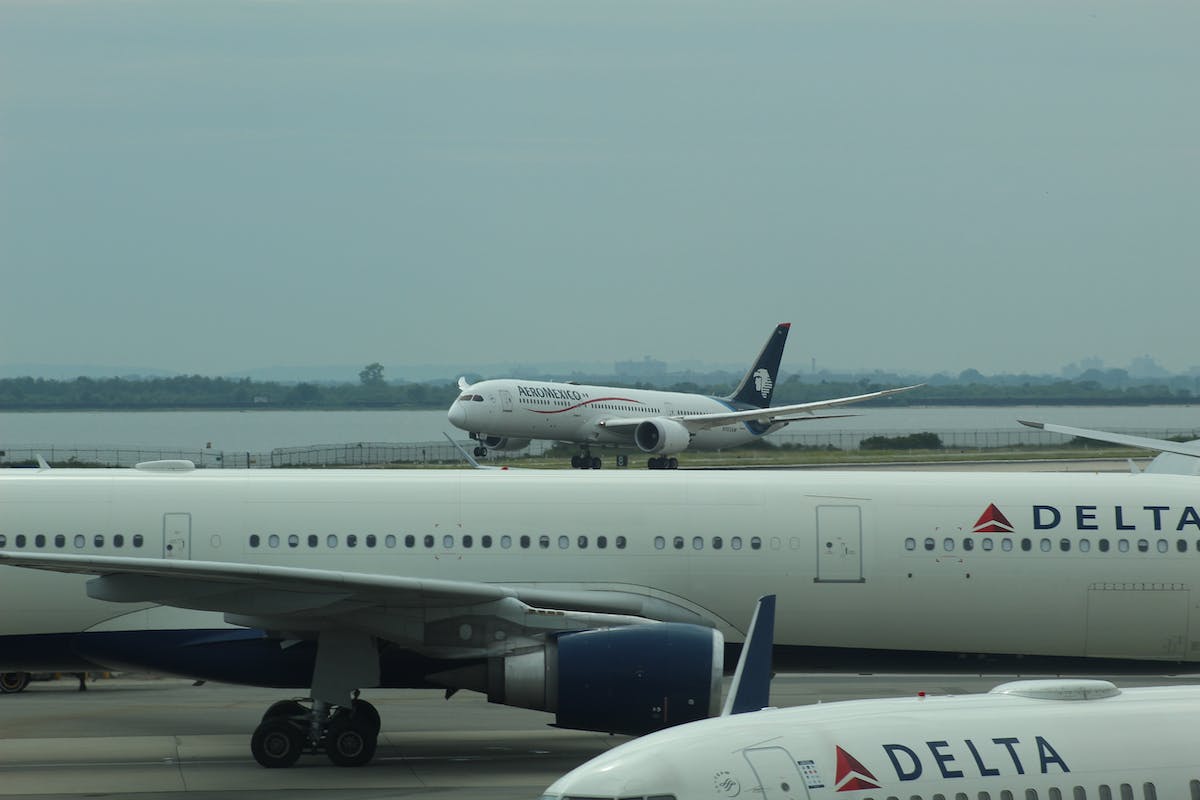

by Signe Hegart
November 1, 2023
In today’s blog post, we will be diving into some fascinating Delta Airline Statistics. As one of the largest and most popular airlines in the world, Delta has a lot to offer both its customers and employees. From on-time performance to fleet size, we’ll explore the key metrics that make Delta stand out. Plus, we’ll also delve into how gift cards to Delta Airlines play a role in enhancing the travel experience. So, let’s take a closer look at some of the numbers behind this industry leader.
Jump to section
What is Delta Airlines?
Delta Air Lines, often referred to simply as Delta, is a major American airline. It is one of the largest and oldest airlines in the United States and a prominent global airline. Delta’s headquarters is located in Atlanta, Georgia. The airline operates an extensive network of domestic and international flights.
As a purpose-driven brand, we connect people to opportunities while expanding the understanding of our planet and the people within it. Both in the air and on the ground, we are focused on lowering our carbon footprint, furthering an equitable work environment that values diversity and inclusion and living these values in the communities where we live, work and serve.
Delta.com
Editor’s pick commonalities & highlights Delta Airline Statistics
- Delta Air Lines peak revenue was $50.6B in 2022
- Delta Air Lines’s revenue growth from 2008 to 2022 is 122.86%
- Delta Air Lines has 86,564 employees
- The average employee at Delta Air Lines makes $36,132 per year
- Delta operates over 5,400 flights daily
- Delta operates flights to over 300 destinations in more than 50 countries
Read also: Giant Eagle Statistics: Uncovering The Numbers
Delta Airlines Statistics ????
Delta Air Lines Inc.’s operating revenue from FY 2012 to FY 2022 (in million U.S. dollars)
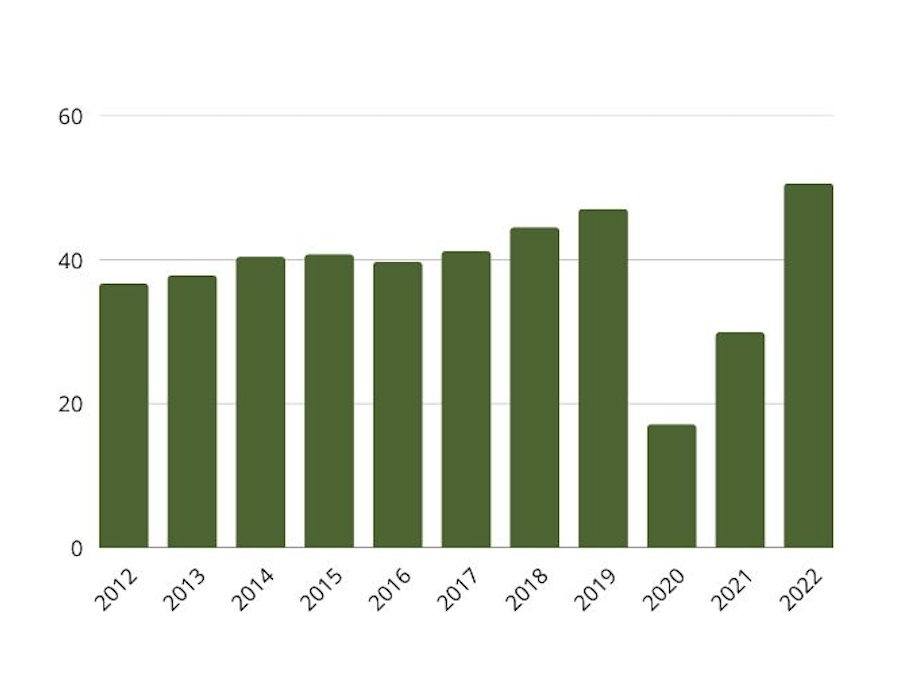
2012: $36.670
2013: $37.773
2014: $40.362
2015: $40.704
2016: $39.639
2017: $41.138
2018: $44.438
2019: $47.007
2020: $17.095
2021: $29.899
2022: $50.582
Source: Statista
Delta Air Lines Inc.’s net income or loss from FY 2012 to FY 2022 (in million U.S. dollars)
2012: $1.009
2013: $10.540
2014: $659
2015: $4.526
2016: $4.373
2017: $3.205
2018: $3.935
2019: $4.767
2020: $-12.385
2021: $280
2022: $1.318
Source: Statista
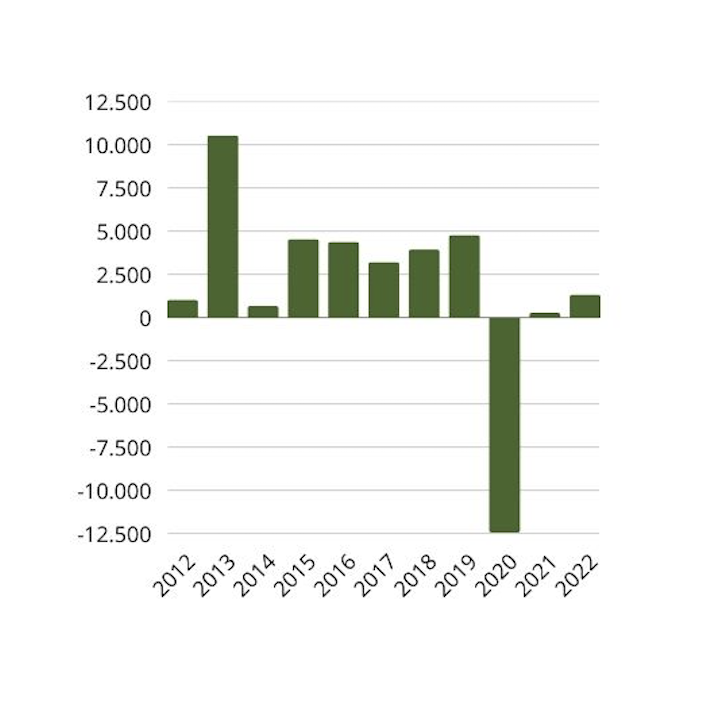
Delta Airlines Statistics: Market share, revenue and value
Delta Airlines is one of the major players in the U.S. aviation industry and has a significant market presence, but specific market share figures can fluctuate due to various factors, including competition, industry trends, and global events.
| Delta | 17.5% |
| American | 17.4% |
| Southwest | 16.9% |
| United | 15.9% |
| Alaska | 6.4% |
| JetBlue | 5.5% |
| Spirit | 5.0% |
| Frontier | 3.6% |
| SkyWest | 2.4% |
| Hawaiian | 1.8% |
| Other | 7.6% |
Market value of selected airlines worldwide as of May 2023 (in billion U.S. dollars)
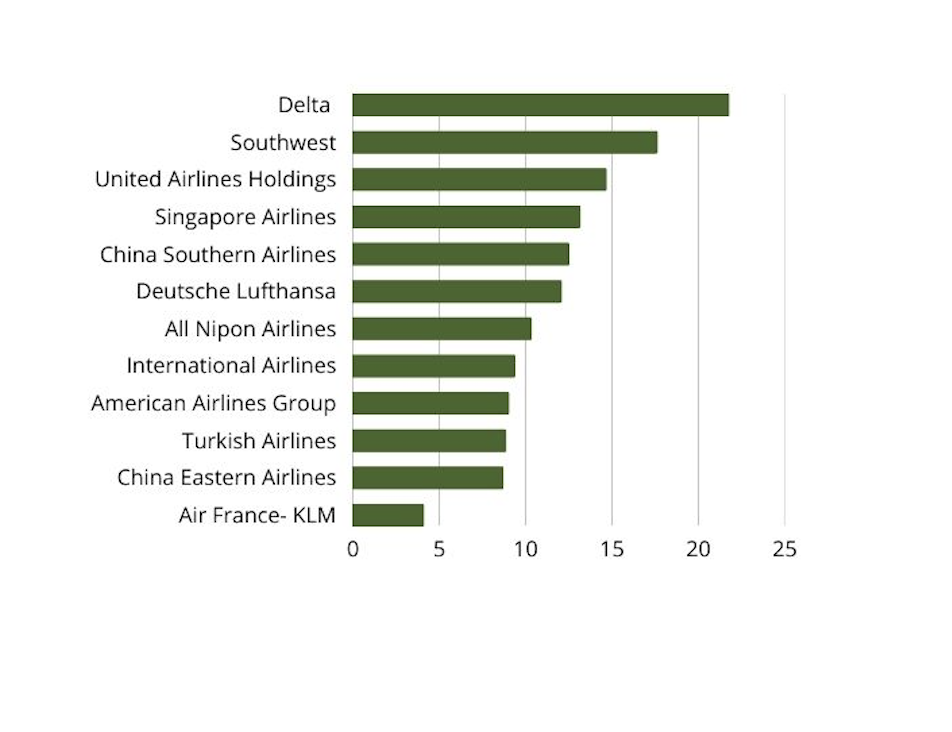
- Delta: $21.81
- Southwest: $17.65
- United Airlines Holdings: $14.7
- Singapore Airlines: $13.18
- China Southern Airlines: $12.54
- Deutsche Lufthansa: $12.1
- All Nipon Airways: $10.36
- International Airlines: $9.41
- American Airlines Group: $9.05
- Turkish Airlines: $8.88
- China Eastern Airlines: $8.72
- Air France- KLM: $4.12
Source: Statista
Operating revenue of selected airline groups in North America in 2022 (in billion U.S. dollars)
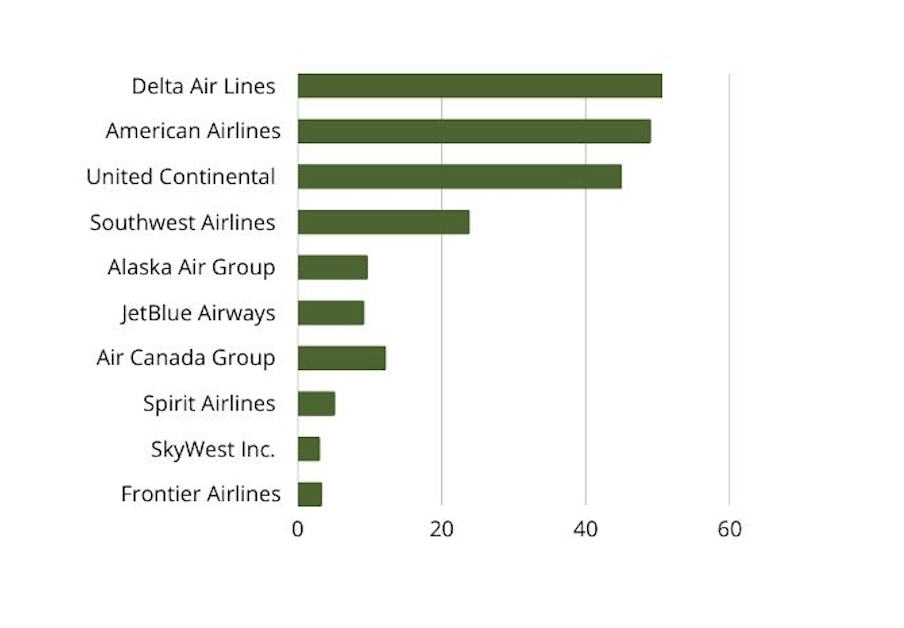
Delta Airlines: $50.58
American Airlines: $48.97
United Continental: $44.96
Southwest Airlines: $23.81
Alaska Air Group: $9.65
JetBlue Airlines: $9.16
Air Canada Group: $12.17
Spirit Airlines: $5.1
SkyWest Inc.: $3
Frontier Airlines: $3.3
Source: Statista
Delta Airlines Statistics: Costumer satisfaction and passenger fare revenue
American customer satisfaction index scores for Delta Air Lines in the United States from 2012 to
2021
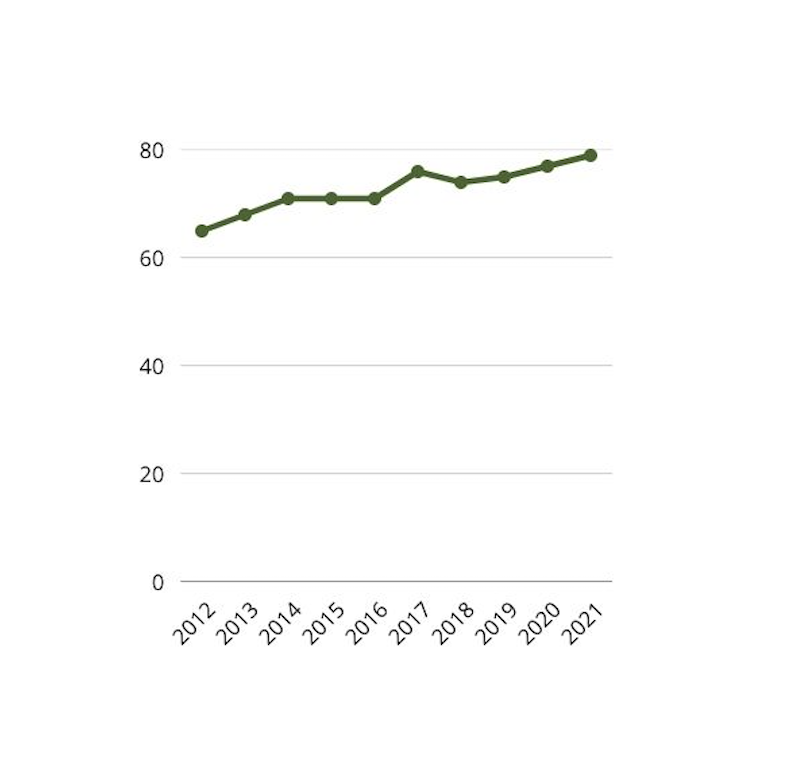
Source: Statista
Passenger fare revenue generated within the U.S. airline industry between 2012 to 2022 (in billion U.S. dollars)

2012: $115.97
2013: $121.36
2014: $127.46
2015: $127.06
2016: $125.92
2017: $130.49
2018: $138.98
2019: $145.44
2020: $49.89
2021: $86.67
2022: $155.12
Source: Statista
Delta Airlines Statistics: Demographics
Most Common Delta Airline Locations
- Atlanta, GA
- Minneapolis, MN
- New York, NY
- Boston, MA
- Detroit, MI
- Salt Lake City, UT
- Seattle, WA
- Cincinnati, OH
- Washington, DC
- Nashville, TN
Source: Zippa


At Delta Airlines, the workforce reflects a diverse composition of individuals contributing to the success of the airline. As of the most recent statistics available, 54.1% of the employees identify as male, while 45.9% identify as female. This gender balance highlights Delta’s commitment to fostering an inclusive and equitable work environment, where talent and expertise are recognized regardless of gender.
Source: Zippa
Read also: Unveiling Lowe´s Statistics: Powerful Insights into a Retail Giant
Delta Airline gift card ????
A Delta Air Lines gift card, often referred to as a Delta gift card or Delta eGift card, is a prepaid card that allows recipients to apply the card’s value toward the purchase of Delta Air Lines tickets, travel services, or in-flight amenities. These gift cards are a convenient and flexible way to give the gift of travel or help someone cover travel expenses.
Here are some key points about Delta Air Lines gift cards:
- Value: You can typically purchase Delta gift cards in various denominations, allowing you to choose the amount that suits your gifting needs.
- Redemption: Recipients can redeem the value of the gift card when booking flights or travel-related services on the Delta Air Lines website or through other official Delta booking channels.
- Versatility: Delta gift cards can be used for purchasing flight tickets, upgrades, baggage fees, in-flight food and beverages, and other travel-related expenses.
- Personalization: You can often personalize Delta gift cards with a custom message for the recipient, making them a thoughtful gift for travelers.
- Validity: Be sure to check the terms and conditions of the gift card, including its expiration date and any usage restrictions.

Send yourself a Delta Airline gift card
Delta Airline Success
Delta Air Lines has achieved success through a combination of factors, strategies, and practices that have contributed to its standing as one of the world’s largest and most prominent airlines. While success in the airline industry is multifaceted, here are some key factors that have contributed to Delta Air Lines’ success:
1. Strong Leadership
– Effective leadership at Delta has involved making strategic decisions that address challenges and opportunities within the airline industry.
– Decisions regarding fleet expansion, mergers and acquisitions, and workforce management have been key in shaping Delta’s growth and success.
2. Customer Focus
– Delta prioritizes customer satisfaction by offering a range of services, including in-flight entertainment, Wi-Fi, and onboard dining options.
– Delta has invested in modernizing its fleet with new aircraft featuring more comfortable cabins, which enhances the overall passenger experience.
3. Operational Excellence
– Operational reliability, including on-time departures and arrivals, baggage handling, and flight safety, has been a hallmark of Delta’s service.
– Punctuality and consistent performance have contributed to passenger loyalty and trust.
4. Strategic Expansion
– Delta has strategically expanded its route network to cater to a wide range of passenger needs, including both domestic and international travel.
– Partnerships with other airlines, as part of the SkyTeam alliance and beyond, have broadened the destinations and options available to Delta’s passengers.
5. Mergers and Acquisitions
– Delta’s successful integration of mergers, particularly the Northwest Airlines merger in 2008, allowed the airline to consolidate operations and expand its footprint.
– Mergers have also enabled the sharing of resources and technology, which has improved efficiency and cost management.
6. Financial Management
– Effective financial management includes optimizing revenue streams, managing costs, and prudent investment.
– Delta’s ability to maintain financial stability during economic challenges and invest in its future success has been a key driver of the company’s growth.
7. Employee Engagement
– Delta’s emphasis on employee engagement and satisfaction has led to a motivated and dedicated workforce.
– Happy employees are more likely to provide excellent service, which has a direct impact on passenger experiences and overall company success.
8. Investment in Technology
– Delta’s investment in technology has improved various aspects of its operations, from booking flights online to providing a seamless travel experience for passengers.
– Cutting-edge technology enhances convenience, efficiency, and passenger satisfaction.
9. Environmental Initiatives
– Delta’s commitment to reducing its environmental footprint includes investing in more fuel-efficient aircraft and sustainable practices.
– These initiatives are not only environmentally responsible but also contribute to cost savings, as fuel efficiency reduces operating expenses.
10. Brand Reputation
– Delta’s strong brand reputation is built on a legacy of safety, reliability, and quality service.
– Recognition for community involvement, philanthropy, and social responsibility also enhances its brand image.
Let’s have a chat
Delta Airline Statistics: Success
Delta Air Lines serves a vast network of over 250 destinations, connecting travelers to all six continents on a daily basis. With a presence in more than 60 countries, this Atlanta-based airline offers comprehensive coverage, bridging the gaps within the United States and reaching international destinations like Istanbul and Rome.
Every day, Delta Air Lines orchestrates over 4,000 flights, solidifying its position as one of the world’s premier global carriers. Notably, in 2021, an impressive 88.4% of Delta flights maintained their top-tier performance, showcasing the airline’s strong performance when compared to its competitors.
Source: Zippa
Read also: Primark Statistics: The Facts You Need To Know
Delta Airlines contribute to sustainability and the environment ????
Delta Air Lines has taken several initiatives and steps to contribute to sustainability and minimize its impact on the environment. Here are some of the key ways in which Delta has worked towards environmental responsibility:
- Fleet Renewal: Delta’s investment in a more fuel-efficient fleet is a cornerstone of its environmental efforts. The introduction of newer, more efficient aircraft models not only reduces the airline’s carbon emissions but also leads to significant fuel cost savings. These modern aircraft are equipped with advanced technology and materials that improve fuel efficiency while reducing noise pollution, contributing to a greener and quieter aviation industry.
- Fuel Efficiency: Delta’s commitment to fuel efficiency goes beyond aircraft renewal. The airline continually optimizes its operations to reduce fuel consumption and emissions. This includes flight planning that seeks to minimize fuel use by selecting the most efficient routes, reducing unnecessary weight on aircraft, and maintaining engines to ensure they operate at peak efficiency. These measures not only benefit the environment but also help control operational costs.
- Carbon Offsetting: Delta offers passengers the option to purchase carbon offsets for their flights. The funds generated from these purchases are invested in environmental projects designed to mitigate carbon emissions. These initiatives may include reforestation, renewable energy projects, and sustainable agricultural practices. By allowing travelers to offset their carbon footprint, Delta actively engages its customers in the fight against climate change.
- Alternative Fuels: Delta has explored the use of alternative fuels, including biofuels, to reduce its reliance on traditional aviation fuels derived from fossil sources. These alternative fuels have the potential to significantly reduce greenhouse gas emissions associated with air travel. Experimenting with biofuels demonstrates the airline’s commitment to exploring innovative and sustainable solutions for the aviation industry.
- Waste Reduction: Delta’s waste reduction programs extend to both in-flight and ground operations. Onboard, the airline emphasizes recycling and reducing single-use plastics. On the ground, the company seeks to minimize waste through responsible disposal and recycling practices. Reducing waste not only benefits the environment but also contributes to operational efficiency.
- Water Conservation: Delta incorporates water-saving measures in various aspects of its operations. This includes initiatives to reduce water consumption in aircraft lavatories and to implement water-efficient landscaping at its facilities. Water conservation is essential for preserving natural resources and minimizing the impact on local ecosystems.
- Renewable Energy: Delta’s investment in renewable energy sources, such as solar power, is part of its broader strategy to transition to cleaner, more sustainable energy solutions. Utilizing renewable energy not only reduces the airline’s carbon footprint but also supports the growth of renewable energy infrastructure.
- Sustainable Practices: The airline adopts sustainable practices in its daily operations, from reducing paper consumption through digital solutions to implementing energy-efficient lighting and sustainable building design. These practices reflect Delta’s commitment to responsible resource management and environmental stewardship.
Conclusion
In conclusion, Delta Airlines is a major player in the aviation industry, with a rich history and a strong commitment to various aspects of its business. We’ve explored some fascinating Delta Airline Statistics statistics and factors that contribute to Delta’s success and its efforts to contribute to sustainability and the environment.
Delta Airlines has grown significantly over the years, with a peak revenue of $50.6 billion in 2022 and a remarkable revenue growth of 122.86% from 2008 to 2022. With a workforce of 86,564 employees, Delta values diversity and inclusion, as 46% of its employees are women.
Delta’s success can be attributed to several key factors, including effective leadership, a strong customer focus, operational excellence, strategic expansion, successful mergers and acquisitions, sound financial management, engaged employees, investment in technology, commitment to environmental initiatives, and a strong brand reputation. These elements have all contributed to Delta’s position as a leading global airline.



Let’s have a chat
FAQ
Delta Airlines consistently ranks among the top airlines in terms of customer satisfaction. According to recent reports, the average customer satisfaction rate for Delta Airlines is around 80%. This is a testament to the company’s commitment to providing exceptional service and meeting the needs of their passengers. Delta Airlines has implemented various initiatives to enhance customer experience, such as improving their on-time performance, upgrading their fleet, and investing in customer service training for their staff. These efforts have clearly paid off, as Delta Airlines continues to receive positive feedback from their customers.
As a company that values punctuality and efficiency, Delta Airlines has consistently maintained a higher on-time arrival rate compared to many other airlines. With a strong focus on customer satisfaction and operational excellence, Delta Airlines has implemented various strategies and measures to ensure on-time performance.
One of the key factors contributing to Delta’s high on-time arrival rate is its robust operational infrastructure. The airline invests heavily in advanced technology and systems to accurately track flights, manage potential delays, and optimize schedules. This allows Delta to proactively address any potential issues and make necessary adjustments to minimize disruptions and ensure on-time arrivals.
Delta Airlines transports approximately 200 million passengers annually.